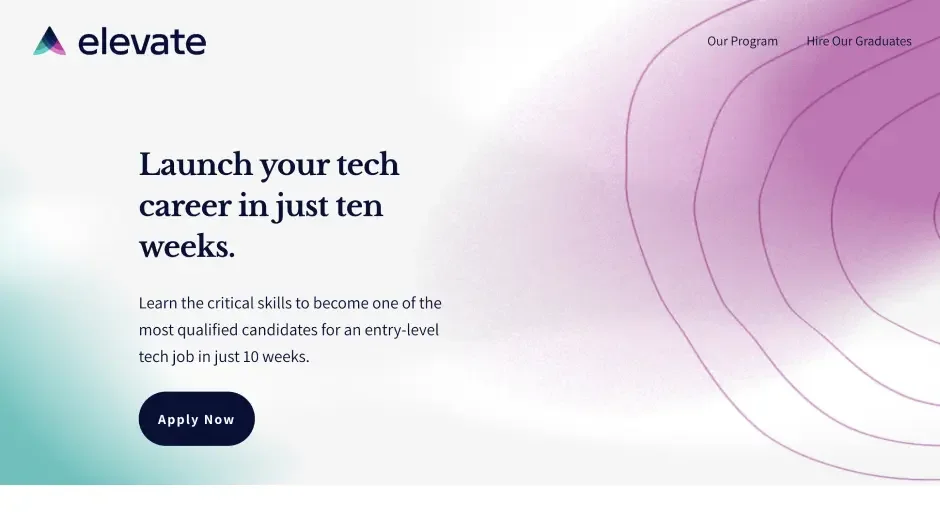Elevate
CMO, Head of Growth & COO (2022–2023)
01 / Context
Elevate was a new kind of workforce education company—designed to bridge the gap between learning and employability. The concept was strong: deliver career-changing programs that connected graduates directly to real employers. The problem was everything else.
When I joined, Elevate was chaos. No unified brand, no systems, no growth structure, and no compliance foundation to even operate at scale. I stepped in to turn vision into structure, and structure into momentum.
02 / What I Walked Into
The chaos was total—the kind that hides in every corner of a startup that’s grown too fast without growing up.
We had:
A product that worked in theory, but not yet in practice.
A half-built brand that no one could explain.
Teams working reactively, with no defined processes or accountability.
Marketing that existed as scattered posts and untracked ads.
Zero compliance or certification—meaning we couldn’t operate legally in our state.
There was no “engine” to optimize. There wasn’t even a car.
That’s where I come in best: at zero, where everything is still clay.
03 / What I Actually Did
My title said Head of Growth—but in reality, I was the integrator, the architect, and the operator.
I was responsible for:
Rebuilding operations from scratch: implementing CRM infrastructure, automating admissions, and structuring internal handoffs between teams.
Leading a full rebrand—voice, visual identity, and message clarity across every touchpoint.
Owning compliance—drafting all documentation for the Arizona State Board of Private Postsecondary Education and preparing our CEO for interviews. We secured full approval under License #NAV-01727.
Designing the growth system: a $1.2M omnichannel campaign that targeted both sides of our funnel—students and hiring partners.
Creating inbound acquisition loops using real student transformation stories and credibility from industry employers.
Mentoring team leads and rebuilding culture around accountability, clarity, and speed.
It wasn’t marketing for a company. It was building the company.
04 / How We Did It (The Work)
Step 1 / Find the pattern beneath the noise
The first step was diagnostic. I mapped every process—from admissions forms to lead tracking—and documented failure points. Ninety percent of the problems weren’t talent issues. They were system issues.
I implemented HubSpot as our central nervous system and rebuilt the entire operational map: who touches what, when, and why.
Suddenly, what had been chaos became measurable.
Step 2 / Create coherence through story
You can’t grow what you can’t articulate. Our external messaging read like five different startups. I rewrote everything from the ground up.
The narrative became clear: education that meets real life—skill programs that actually lead to jobs.
I rebuilt all brand collateral, redesigned our website flow, rewrote all partner decks, and introduced a consistent tone of authority and optimism. For the first time, the company sounded like it knew who it was.
Step 3 / Build legitimacy from the ground up
Without certification, Elevate couldn’t exist. I led the Arizona licensing process personally—handling 300+ pages of documentation, internal audits, interviews, and compliance training.
I turned bureaucracy into narrative: every document was written to tell the story of operational readiness and ethical responsibility.
The result: official approval under License #NAV-01727, unlocking full legal operation and partnership potential.
Step 4 / Build the growth machine
With the foundation in place, we needed traction. I designed a $1.2M campaign architecture that ran across paid, organic, and partnership channels—unified under one goal: to prove transformation.
We built two pipelines:
Students, drawn by career outcomes and peer stories.
Hiring partners, drawn by employer credibility and alumni performance.
I ran weekly sprints focused on experiment velocity: every channel tested, tracked, and iterated. We launched storytelling-based landing pages, alumni-driven content loops, and referral pathways that became our most efficient acquisition source.
Step 5 / Make it stick
The most important part wasn’t growth—it was sustainability.
I documented every new process, trained teams, and established operating rhythms that didn’t rely on me to function. By the time I left, every department had SOPs, dashboards, and a shared understanding of what “good” looked like.
The system could finally scale itself.
05 / What Moved (Impact)
Complete operational rebuild across marketing, admissions, partnerships, and compliance.
Full certification achieved under License #NAV-01727.
$1.2M omnichannel campaign launched and managed end-to-end.
Application and hiring partner pipelines stabilized and growing.
60% reduction in operational inefficiencies through automation and process design.
Unified brand voice, visual identity, and customer experience.
But the real win: Elevate stopped surviving and started performing.
06 / Notes + What I’d Do Next
Elevate reminded me that structure doesn’t kill creativity—it protects it.
When you give a company clear systems, a shared story, and an operational rhythm, people finally get to focus on what matters: delivering the promise.
If I were running this play again, I’d push for earlier lifecycle data integration to tie student outcomes to acquisition narratives in real time. That feedback loop would’ve turned every graduate into living proof of ROI.
From survival to system. That’s the real growth story.
(Elevate is now a fully certified and operational workforce education platform under License #NAV-01727.)
